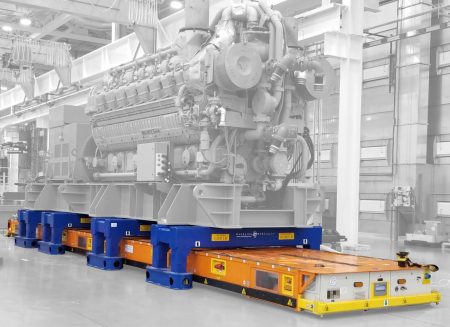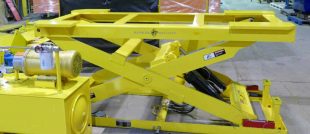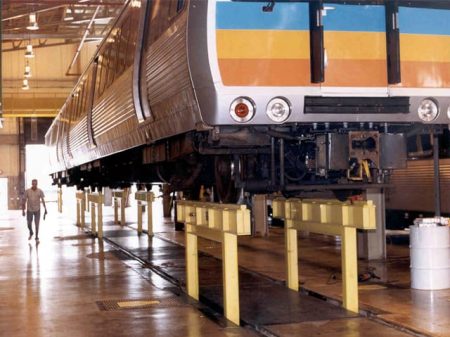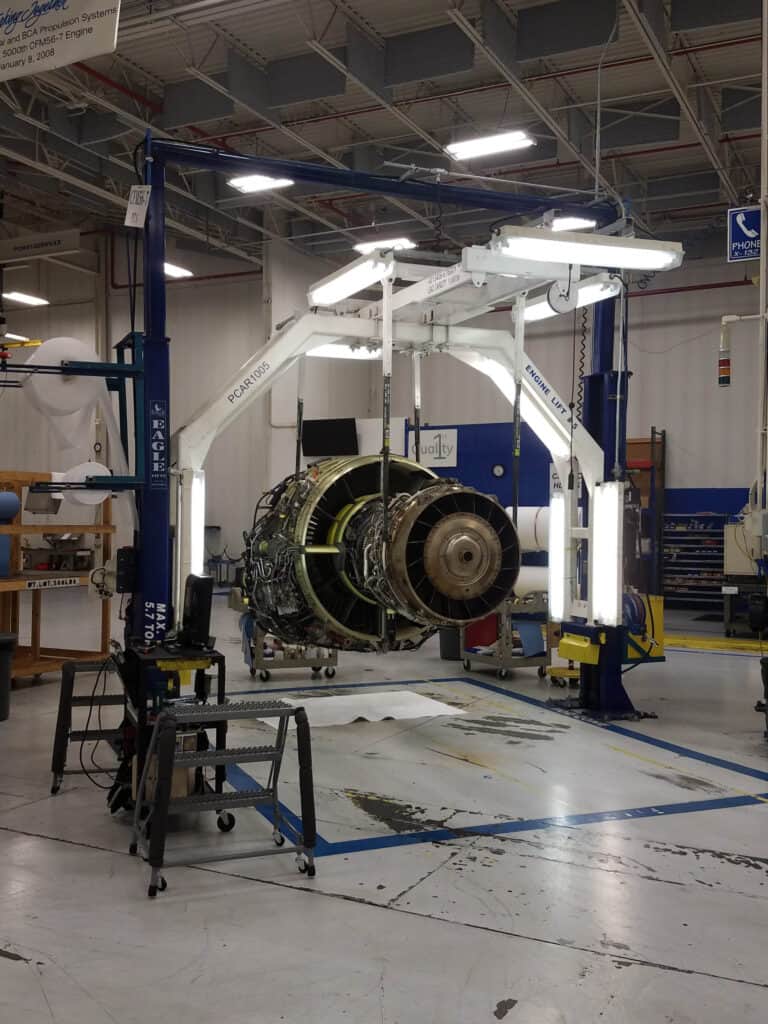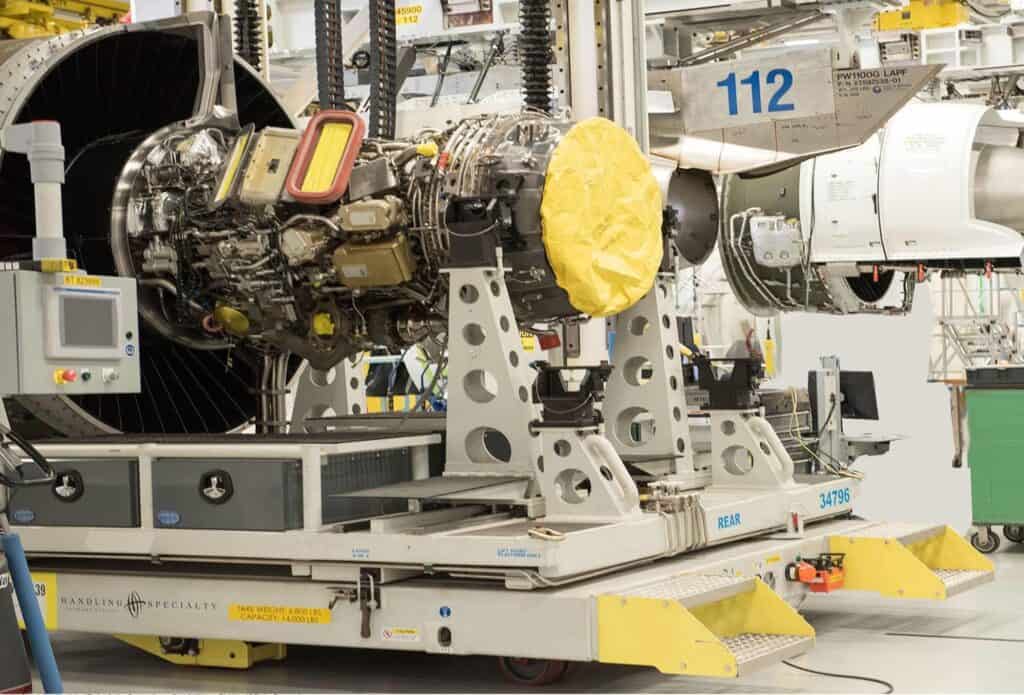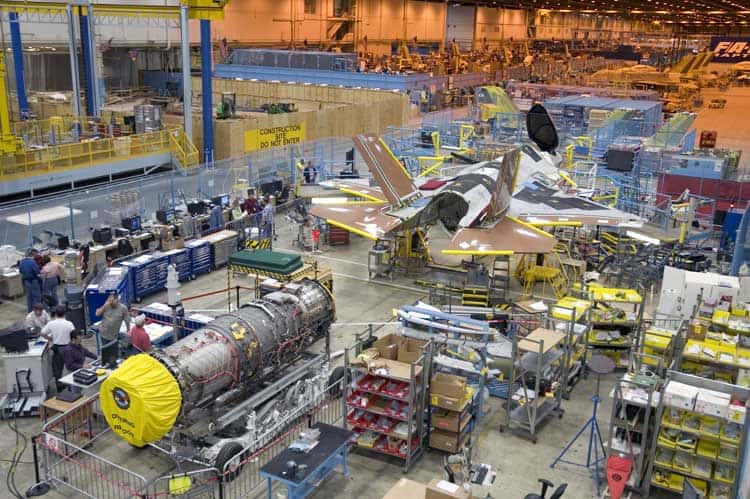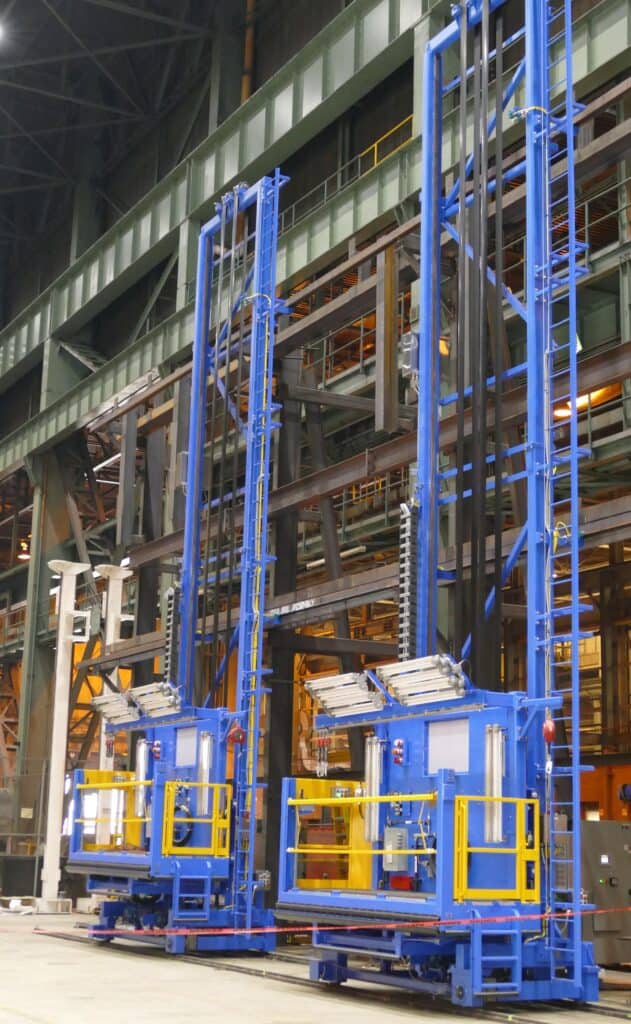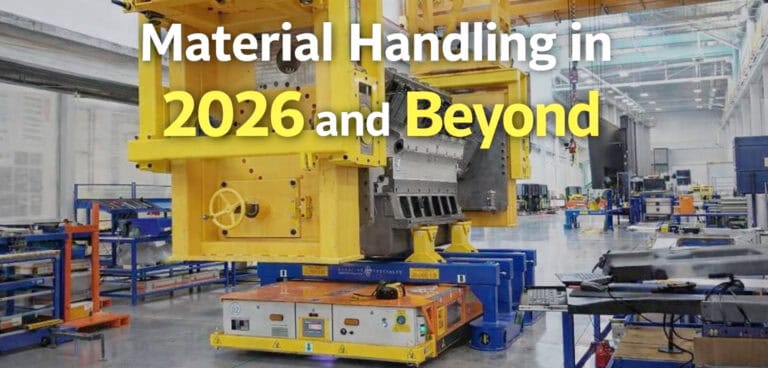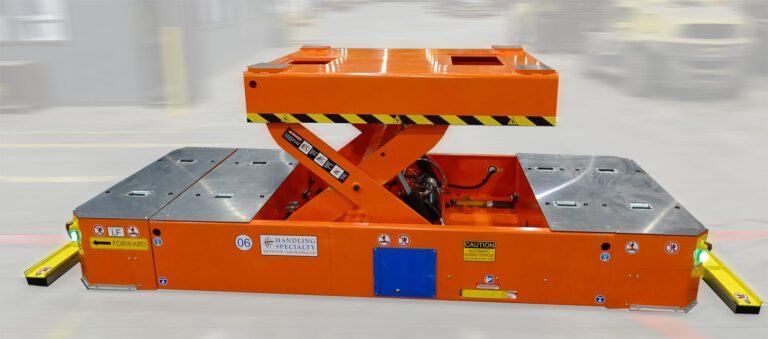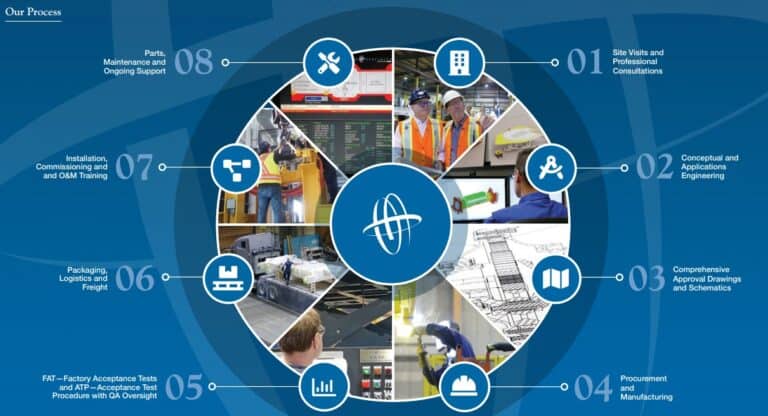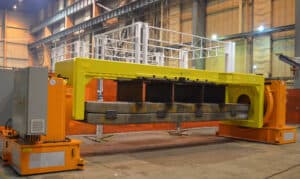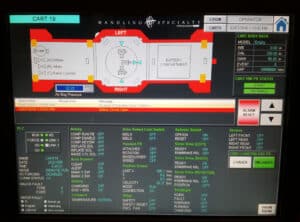Aerospace material handling equipment, crucial in the production and maintenance of aircraft, defense industry products, spacecraft, and related equipment, faces unique challenges. The precision and delicate nature of the components involved often lead to mishandling or accidents, resulting in defects or damage to these high-value parts. This can cause unexpected costs and delays. However, custom lifts have emerged as indispensable tools in aerospace material handling, effectively addressing these challenges.
Custom equipment, specifically designed to meet the unique needs of the aerospace industry, offers tailored solutions for moving, lifting, and positioning aerospace components during assembly, MRO, and manufacturing. These lifts, designed to accommodate aerospace parts’ size, weight, and fragility, ensure their safe and secure transportation within manufacturing facilities, thereby significantly enhancing the efficiency and safety of aerospace material handling.
The significance of custom material handling lifts in aerospace assembly and the various equipment solutions commonly used in the industry can not be overstated. We will delve into the role of automation in enhancing safety and productivity in aerospace material handling. Moreover, we will provide a comprehensive overview of the key considerations when selecting material handling equipment for aerospace applications. This knowledge will empower aerospace companies to optimize their material handling processes and ensure the efficient production and maintenance of aerospace equipment.
Understanding Aerospace Material Handling Needs
Material handling refers to the positioning, moving, and controlling of materials used in manufacturing and maintenance processes. The aerospace industry has specific material handling needs due to the custom nature of the components. Aerospace parts are often made from advanced materials and require careful handling to prevent damage. Advanced material handling is essential to ensure the smooth flow of production and maintenance operations in the aerospace industry. Custom lifts provide specialized solutions to address the specific challenges of aerospace material handling.
The Distinctive Challenges of Aerospace Material Handling
Aerospace material handling presents a myriad of challenges due to the precision required when assembling aerospace components. Manufacturing aerospace parts entails intricate processes and the use of advanced materials, such as titanium alloys and nickel-based super-alloys. These materials are often complex and costly to manufacture, underscoring the need for meticulous handling of parts during the assembly or repair process.
Any mishandling or accidents during material handling can lead to higher costs. Aerospace material handling also involves moving components of various sizes and weights, requiring specialized equipment to ensure safe transportation.
Handling Specialty addresses these challenges by providing efficient and precise custom solutions for aerospace material handling. These solutions are designed to accommodate the unique requirements of aerospace components and ensure their safe and secure transportation within manufacturing and maintenance facilities.
Custom Solutions for Efficiency and Precision
Custom lifts offer several benefits for aerospace material handling. These solutions are designed to meet the specific needs of the aerospace industry, providing tailored solutions for moving, lifting, and positioning components. Some of the critical advantages of custom equipment include:
- Enhanced efficiency: Custom equipment optimize the material handling process by modernising operations and reducing the time required to move aerospace components.
- Improved precision: Custom machinery ensures precise positioning and alignment of aerospace parts, minimizing the risk of errors or damage during the handling process.
- Specialized tooling: Custom solutions are equipped with specialized tooling, such as adjustable platforms, scissor lifts, rotators, and clamps, to securely hold and position aerospace components of various shapes and sizes.
- Ergonomic design: Custom devices are designed with ergonomics in mind. They provide operators with comfortable and safe working conditions, reducing the risk of injuries and fatigue.
- Integration with existing systems: Custom equipment can be seamlessly integrated with existing material handling systems, allowing for efficient workflows and minimal disruption to operations.
Custom material handling equipment improves the efficiency and precision of aerospace material handling, ensuring the smooth flow of production and maintenance processes.
Types of Custom Lifts in Aerospace
Various types of custom lifts are used to address the specific material handling needs of the aerospace industry. These ensure safe and precise transportation. Some of the common types of custom solutions used in aerospace material handling include:
- Automated Guided Vehicles (AGVs): AGVs are computer-controlled wheeled-based load carriers that can autonomously transport aerospace components within manufacturing facilities.
- Specialized lift systems: These lifts are designed to handle specific aerospace components, such as engines or fuselages, with precision and care.
- Lift tables: Lift tables provide adjustable platforms that can be raised or lowered to the desired height, allowing for efficient and ergonomic material handling.
- Overhead lifts: Are used to lift and move aerospace components, providing flexibility in positioning and transportation.
Each type of custom lift offers unique advantages and features, catering to the diverse material handling needs of the aerospace industry.
Automated Guided Vehicles (AGVs) for Aerospace
Automated Guided Vehicles (AGVs) have revolutionized material handling in the aerospace industry—these automated load carriers autonomously transport aerospace components within manufacturing facilities, providing an efficient logistics solution.
AGVs offer several benefits for aerospace material handling:
- Increased productivity: AGVs can operate 24/7, reducing downtime and increasing the overall productivity of material handling operations.
- Improved safety: AGVs are equipped with advanced safety features, such as obstacle detection systems, ensuring the safe transportation of aerospace components.
- Flexibility and scalability: AGVs can be easily programmed and reconfigured to adapt to changing material handling needs, providing flexibility and scalability for aerospace manufacturers.
- Integration with existing systems: AGVs can be seamlessly integrated with existing material handling systems, optimizing workflows and reducing the need for manual labour.
- Specialized tooling: AGVs can be fitted with custom tooling to carry, rotate, and even lift products into position along an assembly line.
AGVs are crucial in simplifying material handling processes in the aerospace industry and enhancing productivity.
Specialized Lift Systems for Aerospace Components
Specialized lift systems are engineered to handle specific aerospace components with precision and care and are tailored to allow safe transportation and positioning.
Some examples of specialized lift systems used in aerospace material handling include:
- Engine lifts: Engine lifts are designed to handle the heavy and delicate engines used in aircraft and spacecraft, providing precise positioning and secure transportation.
- Fuselage lifts: Fuselage lifts lift and move aircraft fuselage sections, ensuring their safe and accurate positioning during assembly.
- Wing assembly lifts: Wing lifts are designed to handle large, fragile aircraft wings, providing controlled lifting and transportation.
The Role of Automation in Aerospace Material Handling
With technological advancements, automation has become an integral part of modern manufacturing processes, including in the aerospace industry.
Automation in aerospace material handling involves using automated systems and equipment to simplify operations and minimize the need for manual labour. By automating material handling tasks, aerospace manufacturers can achieve:
- Increased efficiency: Automated systems can perform material handling tasks with precision and speed, reducing the time required for production and maintenance processes.
- Enhanced safety: Automated systems are equipped with advanced safety features, reducing the risk of accidents and injuries during material handling operations.
- Improved productivity: Automation eliminates manual labour, allowing employees to focus on more complex tasks, thereby increasing overall productivity.
Enhancing Safety and Productivity with Automation
By automating material handling tasks, aerospace manufacturers can create a safer working environment and improve overall operational costs in the long run.
One of the main advantages of automation is reducing manual labour, which minimizes the risk of accidents and injuries and eliminates downtime. Automated systems are equipped with advanced safety features, such as obstacle detection sensors and emergency stop mechanisms, ensuring the safe transportation and positioning of aerospace components.
Automation also enhances productivity by streamlining material handling processes. Automated systems can perform repetitive tasks with precision and speed, reducing the time required for production and maintenance operations. This allows employees to focus on more complex tasks that require human expertise.
Incorporating automation in aerospace material handling improves safety and optimizes workflow and efficiencies, leading to cost savings and improved operational performance.
Case Studies: Successful Implementation of Automated Systems
The successful implementation of automated systems in aerospace material handling has been witnessed in several case studies. These real-world examples highlight the benefits and impact of automation on safety, productivity, and efficiency.
- Handling Specialty’s equipment is used to lift and position the Bellmouth during the assembly of jet engines before they are put into a test cell.
- This custom Aerospace Manually Guided Vehicle for Manufacturing can also act as an AGV following a set path at set speeds.
- This paint booth gantry system, custom-designed and built to position technicians inside a paint booth, comes as a pair of units.
These examples demonstrate the positive impact of automation on material handling processes, highlighting its role in improving safety, productivity, and overall operational performance.
Primary Considerations When Choosing Aerospace Material Handling Equipment
When choosing custom material handling equipment for aerospace applications, you need to understand that aerospace material handling equipment must meet the industry’s specific requirements. Some of the primary considerations include:
- Compatibility with aerospace materials: The equipment must be compatible with the advanced materials used in aerospace manufacturing to prevent damage or contamination.
- Scalability and flexibility: The equipment should be scalable and flexible to accommodate changing material handling needs and adapt to future requirements, such as AGVs.
- Safety features: The equipment should be equipped with advanced safety features, such as obstacle detection systems, sensors, audible and visual alarms, and emergency stop mechanisms, to ensure the safety of operators and components.
- Integration capabilities: The equipment should be easily integrated with existing material handling systems, optimizing workflows and minimizing disruption to operations.
By consulting with Handling Specialty Manufacturing Ltd., aerospace manufacturers can make informed decisions when choosing material handling equipment, ensuring the efficiency and effectiveness of their processes.
Scalability and Flexibility for Future Needs
Aerospace manufacturers need equipment that can adapt to changing material handling requirements and accommodate future tech. Scalable equipment allows for easy expansion or modification of material handling systems as production volumes or component sizes change. This ensures that the equipment can grow with the manufacturing facility, avoiding the need for costly replacements or upgrades. An experienced design/build firm will offer that.
Flexibility in material handling equipment enables manufacturers to handle a wide range of aerospace components with varying sizes and weights. Adjustable platforms, adaptable tooling, and customizable configurations allow for flexible handling of different parts. This flexibility also supports the integration of automated systems and the optimization of material flow within the facility.
By choosing scalable and flexible material handling equipment from Handling Specialty, aerospace manufacturers can future-proof their operations, ensuring long-term efficiency and adaptability.
Benefits of Custom Lifts for Aerospace Applications
Some of the notable benefits of custom lifts for aerospace assembly and MRO operations include:
- Precise positioning: Custom equipment provides accurate positioning and alignment of aerospace components, reducing the risk of errors or damage during transportation.
- Safe handling: Custom lifts are designed to accommodate the unique requirements of aerospace components, ensuring their safe and secure transportation within manufacturing facilities.
- Improved productivity: Custom aerospace solutions streamline material handling processes, reducing the time and effort required to move and position aerospace components.
- Cost savings: Custom lifts help reduce costs associated with rework or component replacement by minimizing errors and damage during material handling.
Custom lifts are important in optimizing material handling in aerospace applications, allowing manufacturers to achieve ideal production and maintenance operations.
Customization Options to Meet Specific Needs
These custom options allow for designing and implementing tailored solutions that optimize operations and maximize productivity.
One customization option is the ability to choose the size and capacity of the custom lift to match the facility’s specific requirements. Whether a small-scale operation or a large manufacturing facility, custom lifts can be designed to handle the load capacities needed.
Another customization option is integrating additional features and technologies to enhance functionality. For example, lifts can be equipped with sensors, alarms, IIoT, and automation systems to enable precise positioning and movement of parts. This customization allows the lifts to meet the requirements of the aerospace manufacturing process.
Implementation Process for Custom Lifts and Automated Systems
Material handling implementation in the aerospace industry involves several steps to ensure seamless integration into existing manufacturing systems.
First, Handling Specialty’s technical salespeople conduct a thorough assessment of the facility’s requirements and challenges to determine the appropriate custom lift and automated system solutions. This includes evaluating the load capacities, space constraints, and specific tasks that need to be performed.
Next, the custom lifts and automated systems are designed and engineered to meet the identified requirements. This involves selecting the necessary components, such as sensors, controllers, tooling, positioning equipment, and actuators, to ensure optimal performance.
The manufacturing process begins once the designs are finalized, and the custom lifts and automated systems are built and assembled according to the approved specifications.
After manufacturing, the custom lifts and automated systems are installed and commissioned. This includes integrating the systems with existing manufacturing processes, training, and ensuring proper functionality and safety.
Close collaboration with suppliers and manufacturers is essential throughout the implementation process to ensure easy integration and address any challenges that may arise. This partnership ensures that the custom lifts and automated systems are successfully deployed and provide the desired requirements.
Working with Suppliers for Seamless Integration
Working with suppliers like Handling Specialty means seamless integration and the necessary expertise and support throughout the implementation process.
Suppliers collaborate closely with the aerospace facility to understand its specific needs and requirements, using their knowledge and experience to recommend the most suitable custom and automated system solutions.
Suppliers also provide valuable input during the design phase, offering insights into the latest technologies and best practices through years of experience. This collaboration ensures that the custom solution is designed to meet the highest standards of performance and functionality.
During the manufacturing and assembly phase, suppliers ensure the timely delivery of the necessary components and equipment. They also work closely with the aerospace facility to address any challenges or modifications that may arise during this stage.
Once the custom lifts and automated systems are installed, suppliers provide technical support and training to the facility’s staff. This confirms that the solution is appropriately operated and maintained for optimal performance.
Conclusion
Custom equipment solutions enhance efficiency and precision in aerospace material handling. By addressing the unique challenges of the aerospace industry, these specialized solutions reduce human error and increase productivity. The inclusion of automated systems further elevates safety standards and streamlines processes. Compatibility, scalability, and flexibility are essential when choosing material handling equipment for aerospace applications. Custom equipment is invaluable in optimizing aerospace operations, and customization options are available to meet specific needs. Collaborating with experienced suppliers is vital in achieving operational excellence for seamless integration and successful deployment.
Frequently Asked Questions
What are the key benefits of using custom lifts in aerospace material handling?
Custom lifts in aerospace material handling offer benefits such as reducing human error, increasing efficiency, and providing customization options for specific needs. These lifts enhance precision and safety when handling aerospace components.
How do automated systems enhance aerospace material handling processes?
Automated systems enhance aerospace material handling by increasing efficiency and safety. They streamline operations, reduce human error, and ensure precise component handling, which is crucial in the industry’s demanding environment.
Can custom lifts be integrated with existing aerospace manufacturing systems?
Custom lifts can be seamlessly integrated with existing aerospace manufacturing systems. By customizing the lift solutions to meet specific needs, compatibility and scalability, as well as enhanced efficiency and productivity in aerospace material handling operations, are ensured.
What factors should be considered when selecting material handling equipment for aerospace?
When selecting material handling equipment for aerospace, factors include researching an experienced design/build firm, compatibility with materials, scalability for future needs, safety features, and precision requirements.

